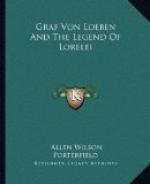The situation, then, is as follows: Heine had to have a source or sources, There are three candidates for Heine honors; Brentano, Loeben, Schreiber. Brentano has a number of supporters, though the evidence, external and internal, is wholly lacking. It would seem that lack of attention to chronology has misled investigators. Brentano’s ballad can now be read in many places, but between about 1815 and 1823 it was safely concealed in the pages of an unread and unknown novel. Loeben[72] has many supporters, though the external evidence, except for the fact that Heine corresponded with Brockhaus, is wholly lacking, and the internal weakens on careful study. It would seem that the striking similarity in form has misled investigators. Schreiber has only one supporter, despite the fact that the evidence, external and internal, is as strong as it can be without Heine’s ever having made some such remark as the following: “Yes, in 1823 I knew only Schreiber’s saga and borrowed from it.” But Heine never made any such statement. It would seem that the strong assertions of so many investigators in favor of Brentano and Loeben have made careful study of the matter appear not worth while; the problem was apparently solved. And since Heine never committed himself in this connection, the matter will, in all probability, remain forever conjectural. This much, however, is irrefutable: even if Heine knew in 1823 the five Loreleidichtungen, that had then been written, those by Brentano, Niklas Vogt, Eichendorff, Schreiber, and Loeben, and if he borrowed what he needed from all of them, he borrowed more from Schreiber[73] than from the other four combined.[74]
III
Whore Brentano sowed, many have reaped. Since the publication of his Godwi, about sixty-five Loreleidichtungen[75] have been written in German, the most important being those by Brentano (1810-16), Niklas Vogt[76] (1811), Eichendorff (ca. 1812), Loeben (1821), Heine (1823), Simrock (1837, 1840), Otto Ludwig (1838), Geibel (1834, 1846), W. MUeller von KOenigswinter (1851), Carmen Sylva, (ca. 1885), A. L’Arronge (1886), Julius Wolff (1886), and Otto Roquette (1889). In addition[77] to these, the story has been retold[78] many times, with slight alterations of the “original” versions, by compilers of chrestomathies, and parodies have been written on it. There is hardly a conceivable interpretation that has not been placed upon the legend.[79] The Lorelei has been made by some the evil spirit that entices men into hazardous games of chance, by others, she is the lofty incarnation of a desire to live and be blessed with the love that knows no turning away. The story has also wandered to Italy, France, England, Scotland, Scandinavia, and the United States,[80] and the heroine has proved a grateful theme for painters and sculptors. Of the epic works, that by Julius Wolff is of interest because of the popularity it




